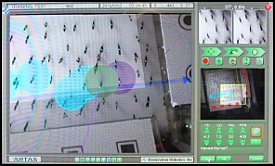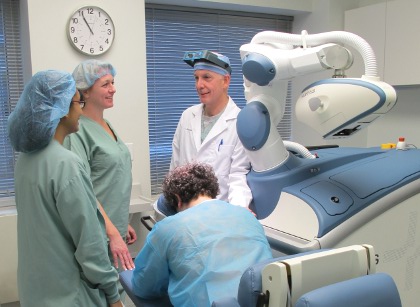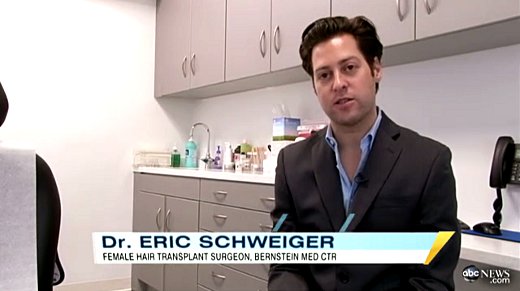Q: Does Robotic FUE leave any scars? — T.B, White Plains, NY
A: Robotic FUE leaves the same tiny, white scars in the donor area produced by manual Follicular Unit Extraction.
Q: Does Robotic FUE leave any scars? — T.B, White Plains, NY
A: Robotic FUE leaves the same tiny, white scars in the donor area produced by manual Follicular Unit Extraction.
How Long After Hair Transplant Can Grafts Fall Out? Dr. Bernstein answers a frequently-asked question about caring for your scalp after your hair transplant.
 Dr. Bernstein is quoted extensively in an article on robotic hair transplantation in the online magazine American Health & Beauty.
Dr. Bernstein is quoted extensively in an article on robotic hair transplantation in the online magazine American Health & Beauty.
In “ARTAS: A Faster and More Accurate Hair Transplant Using Robotics?” Dr. Bernstein explains the benefits of robotic FUE over traditional FUE hair transplant procedures. He describes how the new robotic device overcomes some important limitations of FUE when performed manually. To better understand the role of the new instrument, Dr. Bernstein simplifies the FUE procedure into four basic steps and discusses where the image-guided robotic system fits into this process.
Q: I heard that Propecia stops working after five years. Is this true and why in five years? — B.P., Stamford, CT
A: That is not correct. Although the effects of Propecia (finasteride 1mg) will diminish over time, it does continue to work. Using finasteride long-term will still be better than stopping it at some arbitrary interval. In clinical practice, I often increase the dose of finasteride, after someone had been on the medication 3 to 5 years, to help maintain its effectiveness.
Summary of “Hair Regrowth Following a Wnt- and Follistatin-Containing Treatment: Safety and Efficacy in a First-in-man Phase 1 Clinical Trial,” which was originally published in the November 2011 issue of the Journal of Drugs in Dermatology (Volume 10, Issue 11).
Researchers were aware of the importance of follistatin, a binding protein; Wnt 7a, a signaling protein; and wound healing factors on hair growth. In this study, researchers tested the safety and efficacy of an injection of a mixture of naturally derived molecules on hair growth.
The mixture called the Hair Stimulating Complex (HSC), contained follistatin, as well as keratinocyte growth factor (KGF), and vascular endothelial growth factor (VEGF). The mixture also showed activity similar to the Wnt signaling protein.
Zimber MP, et al. 2011
Is FUE Hair Transplant Painless, Non-Surgical? In this video Q&A clip, Dr. Bernstein dispels a couple of myths about Follicular Unit Extraction and compares FUE hair transplant surgery to Follicular Unit Transplantation (FUT). Watch Dr. Bernstein’s video response.
 Robert M. Bernstein, M.D., F.A.A.D., world-renowned pioneer of the Follicular Unit Transplantation (FUT) and Follicular Unit Extraction (FUE) hair transplant techniques and founder of Bernstein Medical – Center for Hair Restoration, will become the first hair transplant surgeon on the East Coast to use the robotic ARTAS System for Hair Restoration. Procedures using the computer-driven, automated system will begin in November 2011 in his state-of-the-art New York City facility.
Robert M. Bernstein, M.D., F.A.A.D., world-renowned pioneer of the Follicular Unit Transplantation (FUT) and Follicular Unit Extraction (FUE) hair transplant techniques and founder of Bernstein Medical – Center for Hair Restoration, will become the first hair transplant surgeon on the East Coast to use the robotic ARTAS System for Hair Restoration. Procedures using the computer-driven, automated system will begin in November 2011 in his state-of-the-art New York City facility.
 Dr. Schweiger, our resident expert on hair loss in women, was featured in a segment about hair extensions on “Good Morning America” and ABC News online.
Dr. Schweiger, our resident expert on hair loss in women, was featured in a segment about hair extensions on “Good Morning America” and ABC News online.
While many women extoll the cosmetic virtues of hair extensions — they are designed to add to the length and fullness of one’s hair — many others have realized the potential for extensions to cause hair loss. Read the rest of the post.
In this clip of a video interview with Dr. Bernstein, the doctor describes why current hair transplant techniques achieve such natural results — especially when compared to the old “hair plug” methods.
Q: I have been reading various articles and forum postings and it would seem that a person utilizing Propecia might experience increased “shedding” of hairs (outside of the normal hair cycle) around the 12 week mark after a hair transplant and lasting around 2-4 weeks. The forum postings suggest that one will see not only the miniaturized hairs being lost but also normal terminal hair in larger than expected levels. Does an explanation exist to explain this increase in shedding hairs?
A: Our understanding is that finasteride only affects miniaturized hairs — i.e. hair affected by DHT — and that this is all that should be shed. Remember, however, that much of the thinning a bald person experiences is due to thousands of partially miniaturized hair, and these can look very much like a full terminal hair in its early stages.